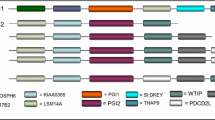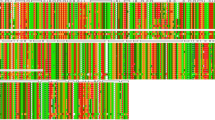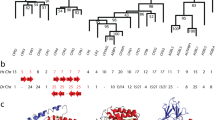Abstract
Structural–functional divergence is responsible for the preservation of highly homologous genes. Protein functions affected by mutagenesis in divergent sequences require investigation on an individual basis. In the present study, comparative homology modeling and predictive bioinformatics analysis were used to reveal for the first time the subfunctionalization of two pyruvate dehydrogenase kinase (PDK) isozymes in the western clawed frog Xenopus tropicalis. Three-dimensional structures of the two proteins were built by homology modeling based on the crystal structures of mammalian PDKs. A detailed comparison of them revealed important structural differences that modify the accessibility of the nucleotide binding site in the two isozymes. Based on the generated models and bioinformatics data analysis, the differences between the two proteins in terms of kinetic parameters, metabolic regulation, and tissue distribution are predicted. The results obtained are consistent with the idea that one of the xtPDKs is the major isozyme responsible for metabolic control of PDC activity in X. tropicalis, whereas the other one has more specialized functions. Hence, this study provides a rationale for the existence of two closely related PDK isozymes in X. tropicalis, thereby enhancing our understanding of the functional evolution of PDK family genes.







Similar content being viewed by others
References
Yeaman SJ, Hutcheson ET, Roche TE, Pettit FH, Brown JR, Reed LJ, Watson DC, Dixon GH (1978) Sites of phosphorylation on pyruvate dehydrogenase from bovine kidney and heart. Biochemistry 17:2364–2370
Sale GJ, Randle PJ (1981) Analysis of site occupancies in [32P]phosphorylated pyruvate dehydrogenase complexes by aspartyl-prolyl cleavage of tryptic phosphopeptides. Eur J Biochem 120:535–540
Popov KM, Kedishvili NY, Zhao Y, Shimomura Y, Crabb DW, Harris RA (1993) Primary structure of pyruvate dehydrogenase kinase establishes a new family of eukaryotic protein kinases. J Biol Chem 268:26602–26606
Harris RA, Popov KM, Zhao Y, Kedishvili NY, Shimomura Y, Crabb DW (1995) A new family of protein kinases—the mitochondrial protein kinases. Adv Enzyme Regul 35:147–158
Bowker-Kinley M, Popov KM (1999) Evidence that pyruvate dehydrogenase kinase belongs to the ATPase/kinase superfamily. Biochem J 344:47–53
Machius M, Chuang JL, Wynn RM, Tomchick DR, Chuang DT (2001) Structure of rat BCKD kinase: nucleotide-induced domain communication in a mitochondrial protein kinase. Proc Natl Acad Sci USA 98:11218–11223
Steussy CN, Popov KM, Bowker-Kinley MM, Sloan RB Jr, Harris RA, Hamilton JA (2001) Structure of pyruvate dehydrogenase kinase. Novel folding pattern for a serine protein kinase. J Biol Chem 275:37443–37450
Dutta R, Inouye M (2000) GHKL, an emergent ATPase/kinase superfamily. Trends Biochem Sci 25:24–28
Knoechel TR, Tucker AD, Robinson CM, Phillips C, Taylor W, Bungay PJ, Kasten SA, Roche TE, Brown DG (2006) Regulatory roles of the N-terminal domain based on crystal structures of human pyruvate dehydrogenase kinase 2 containing physiological and synthetic ligands. Biochemistry 45:402–415
Kato M, Chuang JL, Tso SC, Wynn RM, Chuang DT (2005) Crystal structure of pyruvate dehydrogenase kinase 3 bound to lipoyl domain 2 of human pyruvate dehydrogenase complex. EMBO J 24:1763–1774
Bowker-Kinley MM, Davis WI, Wu P, Harris RA, Popov KM (1998) Evidence for existence of tissue-specific regulation of the mammalian pyruvate dehydrogenase complex. Biochem J 329:191–196
Baker JC, Yan X, Peng T, Kasten S, Roche TE (2000) Marked differences between two isoforms of human pyruvate dehydrogenase kinase. J Biol Chem 275:15773–15781
Korotchkina LG, Patel MS (2001) Site specificity of four pyruvate dehydrogenase kinase isoenzymes toward the three phosphorylation sites of human pyruvate dehydrogenase. J Biol Chem 276:37223–37229
Ono K, Radke GA, Roche TE, Rahmatullah M (1993) Partial activation of the pyruvate dehydrogenase kinase by the lipoyl domain region of E2 and interchange of the kinase between lipoyl domain regions. J Biol Chem 268:26135–26143
Liu S, Baker JC, Roche TE (1995) Binding of the pyruvate dehydrogenase kinase to recombinant constructs containing the inner lipoyl domain of the dihydrolipoyl acetyltransferase component. J Biol Chem 270:793–800
Tuganova A, Boulatnikov I, Popov KM (2002) Interaction between the individual isoenzymes of pyruvate dehydrogenase kinase and the inner lipoyl-bearing domain of transacetylase component of pyruvate dehydrogenase complex. Biochem J 366:129–136
Roche TE, Hiromasa Y, Turkan A, Gong X, Peng T, Yan X, Kasten SA, Bao H, Dong J (2003) Essential roles of lipoyl domains in the activated function and control of pyruvate dehydrogenase kinases and phosphatase isoform 1. Eur J Biochem 270:1050–1056
Hiromasa Y, Roche TE (2003) Facilitated interaction between the pyruvate dehydrogenase kinase isoform 2 and the dihydrolipoyl acetyltransferase. J Biol Chem 278:33681–33693
Gudi R, Bowker-Kinley MM, Kedishvili NY, Zhao Y, Popov KM (1995) Diversity of the pyruvate dehydrogenase kinase gene family in humans. J Biol Chem 270:28989–28994
Rowles J, Scherer SW, Xi T, Majer M, Nickle DC, Rommens JM, Popov KM, Harris RA, Riebow NL, Xia J, Tsui LC, Bogardus C, Prochazka M (1996) Cloning and characterization of PDK4 on 7q21.3 encoding a fourth pyruvate dehydrogenase kinase isoenzyme in human. J Biol Chem 271:22376–22382
Hellsten U et al (2010) The genome of western clawed frog Xenopus tropicalis. Science 328:633–636
Force A, Lynch M, Pickett FB, Amores A, Yan Y, Postlethwait J (1999) Preservation of duplicate genes by complementary, degenerative mutations. Genetics 151:1531–1545
Lynch M, Force A (2000) The probability of duplicate gene preservation by subfunctionalization. Genetics 154:459–473
Thompson JD, Higgins DG, Gibson TJ (1994) CLUSTAL W: improving the sensitivity of progressive multiple sequence alignment through sequence weighting, position-specific gap penalties and weight matrix choice. Nucleic Acid Res 22:4673–4680
Jaroszewski L, Rychlewski L, Li Z, Li W, Godzik A (2005) FFAS03: a server for profile–profile sequence alignments. Nucleic Acid Res 33:W284–288
Gouet P, Courcelle E, Stuart D, Metoz F (1999) ESPript: Multiple sequence alignments in postscript. Bioinformatics 15:305–308
Peitsch MC, Wells TN, Stampf DR, Sussman JL (1995) The Swiss-3DImage collection and PDB-Browser on the World-Wide Web. Trends Biochem Sci 20:82–84
Schwede T, Kopp J, Guex N, Peitsch MC (2003) SWISS-MODEL: an automated protein homology-modeling server. Nucleic Acids Res 31:3381–3385
Arnold K, Bordoli L, Kopp J, Schwede T (2006) The SWISS-MODEL workspace: a web-based environment for protein structure homology modeling. Bioinformatics 22:195–201
DeLano WL (2002) The PyMOL molecular graphics system. DeLano Scientific, San Carlos. http://www.pymol.org
Guex N, Peitsch MC (1997) SWISS-MODEL and the Swiss-PdbViewer: an environment comparative protein modeling. Electrophoresis 18:2714–2723
Laskowski RA, MacArthur MW, Moss DS, Thornton JM (1993) PROCHECK: a program to check the stereochemical quality of protein structures. J Appl Crystallogr 26:283–291
Benkert P, Tosatto SCE, Schomburg D (2008) QMEAN: a comprehensive scoring function for model quality assessment. Proteins 71:261–277
Benkert P, Künzli M, Schwede T (2009) QMEAN server for protein model quality estimation. Nucleic Acids Res 37:W510–514
Voss NR, Gerstein M, Steitz TA, Moore PB (2006) The geometry of the ribosomal polypeptide exit tunnel. J Mol Biol 360:893–906
Camps J, Carrillo O, Emperador A, Orellana L, Hospital A, Rueda M, Cicin-Sain D, D’Abramo M, Gelpí JL, Orozco M (2009) FlexServ: an integrated tool for the analysis of protein flexibility. Bioinformatics 25:1709–1710
Bryson K, McGuffin LJ, Marsden RL, Ward JJ, Sodhi JS, Jones DT (2005) Protein structure prediction servers at University College London. Nucleic Acids Res 33:W36–38
Jones DT (1999) Protein secondary structure prediction based on position-specific scoring matrices. J Mol Biol 292:195–202
Cole C, Barber JD, Barton GJ (2008) The Jpred 3 secondary structure prediction server server. Nucleic Acids Res 35:W197–201
Ward JJ, Sodhi JS, McGuffin LJ, Buxton BF, Jones DT (2004) Prediction and functional analysis of native disorder in proteins from the three kingdoms of life. J Mol Biol 337:635–645
Green T, Grigoryan A, Klyuyeva A, Tuganova A, Luo M, Popov KM (2008) Structural and functional insights into the molecular mechanisms responsible for the regulation of pyruvate dehydrogenase kinase 2. J Biol Chem 283:15789–15798
Ono K, Radke GA, Roche TE, Rahmatullah M (1993) Partial activation of the pyruvate dehydrogenase kinase by the lipoyl domain region of E2 and interchange of the kinase between lipoyl domain regions. J Biol Chem 268:26135–26143
Backer JC, Yan X, Peng T, Kasten S, Roche TE (2000) Marked difference between two isoforms of human pyruvate dehydrogenase kinase. J Biol Chem 275:15773–15781
Author information
Authors and Affiliations
Corresponding author
Electronic supplementary material
Below is the link to the electronic supplementary material.
Table S1
Interaction energies (kJ/mol) of amino acid residues located in the xtPDK3 ATP lid. (PDF 66 kb)
Table S2
Interaction energies (kJ/mol) of amino acid residues located in the xtPDK4 ATP lid. (PDF 40 kb)
Fig. S1
Ramachandran plot of the xtPDK3 model obtained by PROCHECK. (PDF 243 kb)
Fig. S2
Ramachandran plot of the xtPDK4 model obtained by PROCHECK. (PDF 251 kb)
Fig. S3
Estimation of absolute quality (left) and density plot of the QMEAN score (right) for the xtPDK3 model. (PDF 82 kb)
Fig. S4
Estimation of absolute quality (left) and density plot of the QMEAN score (right) for the xtPDK4 model. (PDF 219 kb)
Fig. S5
Estimated residue error in the models of xtPDK3 (a) and xtPDK4 (b) visualized using a color gradient. (PDF 88 kb)
Fig. S6
Analysis of xtPDK4 flexibility. Backbone and sequence of the modeled xtPDK4 protein are shown, colored by B factor. (PDF 166 kb)
Fig. S7
Structure predictions for the C-terminal regions of the xtPDKs. The results of secondary structure predictions obtained using the Jpred3 proteomics server are shown. (PDF 36 kb)
Rights and permissions
About this article
Cite this article
Tokmakov, A.A. Comparative homology modeling of pyruvate dehydrogenase kinase isozymes from Xenopus tropicalis reveals structural basis for their subfunctionalization. J Mol Model 18, 2567–2576 (2012). https://doi.org/10.1007/s00894-011-1281-3
Received:
Accepted:
Published:
Issue Date:
DOI: https://doi.org/10.1007/s00894-011-1281-3




